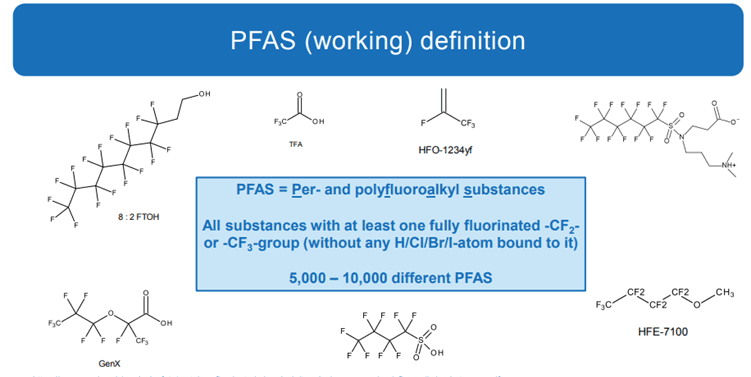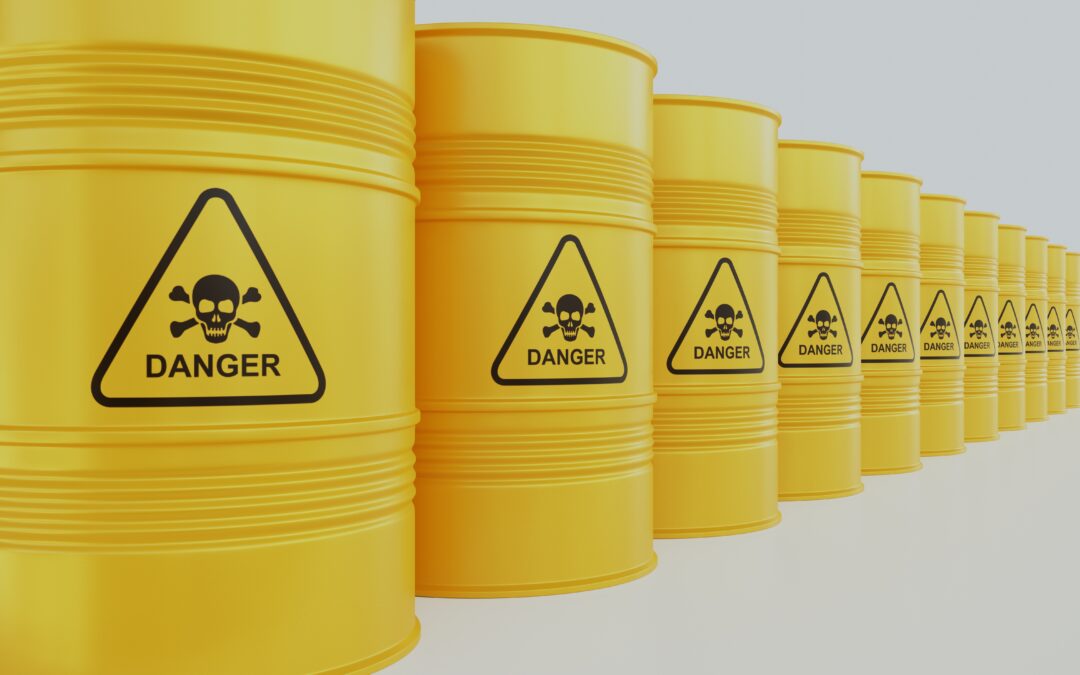Table of Contents
PFAS here, PFAS there, PFAS is everywhere we turn in mid-2023. The newest acronym-cum-neologism in the global specialty chemicals industry is the (often pejorative) noun “PFAS,” (per- and polyfluoroalkyl substances), which has come into universal usage when invoking any chemical included in a family of fluorine-containing chemical compounds that are used by a nearly endless list of manufacturers producing a staggering number of products for a seemingly infinite number of applications in virtually all market and product segments. Thanks to their unique properties and unmatched performance, fluoropolymers are used across all sectors of the global economy, including numerous cutting-edge applications. Driven by global megatrends such as the energy transition and digitalization, they are key enablers of major innovations across a wide range of critical industries.[1] All of this notwithstanding, in mid-2023, PFAS is a problem—and it is a problem for two reasons:
- There is a significant body of evidence that suggests that a small number of chemical compounds in the PFAS family are both bioaccumulative and hazardous to the human body.
- As a result, there is a distressingly diverse call from many interest groups, including regulators, NGOs, manufacturers, the media, and the public, to ban all PFAS. This “call to ban” is not dissimilar to the call initiated by Greenpeace in 1992 to ban the use of chlorine worldwide because of a small number of toxic and/or problematic chemicals that contained chlorine.
Not that certain substances classified as being PFAS have not been studied and discussed in the past, because such discussions go back to at least the year 2000 with the most studied members of the PFAS family, such as perfluorooctanoic acid (PFOA) and perfluorooctane sulfonic acid (PFOS). Nonetheless, it appears that such discussions and studies were merely serving to initiate an induction period to help prepare us for the assault now being conducted on PFAS from all sides.
Regulatory bodies all over the world are busy discussing PFAS, and—because they are focusing on this topic—they are forcing all producers of PFAS-containing chemical products, as well as manufacturers of articles that incorporate these chemical products, to not only discuss PFAS but to give serious thought to either how to rid their products of PFAS or to why their PFAS-containing products must be protected at all costs. This is not a trivial task, because this is not a trivial topic—it is a topic of huge import that has potential impact upon some of the industries that the global community is counting upon for future growth and advancement of technology and living standards.
According to the most frequently cited sources, there are anywhere between 3,700-10,000 members in the PFAS family of fluorine-containing chemical compounds, depending upon which study one consults. (The U.S. Environmental Protection Agency [U.S. EPA], for example, had counted “about 12,000 different kinds of PFAS”[2] as of February 2022, but this is at the extreme end of the estimates.) It is important to recognize that the major issue is not the total number of family members that are contained within the definition of PFAS, but rather:
- How many of them are potentially harmful, and
- How many producers, users, and regulatory bodies are going to determine which chemicals included in the term “PFAS” must be eliminated from use and which may continue to be used, possibly with additional safety measures and safeguards to prevent escape to the environment.
The great English essayist, historian, philosopher, and translator, Thomas Carlyle, placed a striking metaphor firmly into the English vernacular when he translated the German proverb, “Das Kind mit dem Bade ausschütten,” as “Don’t throw the baby out with the bathwater.” This is precisely what would be accomplished by banning all PFAS—and this is why the current clamor to do so is a problem of global scientific, technological, industrial, governmental, and social magnitude.
PFAS Fundamentals
Virtually everywhere we look, we find PFAS fulfilling critical roles in a broad variety of industrial- and consumer-facing applications. Examples range from nonstick cookware; firefighting foams; stain-resistant fabric and carpets; water-, stain-, and grease-resistant consumer goods food packaging; dental floss; and waterproof clothing to propellants; refrigerants; pharmaceuticals (both packaging and contents); blowing agents; highly durable building products for exterior cladding; and myriad other applications (see Figures 1-4).

(Source: The ChemQuest Group, Inc.)

(Source: The ChemQuest Group, Inc.)

(Source: The ChemQuest Group, Inc.)

(Source: Global Industry Council for FluoroTechnology (FluoroCouncil))
Certain PFAS are absolutely critical in the production of microchips by companies such as Intel, Infineon, BASF, and others. “Without some PFAS, semiconductor manufacturing is simply not possible,” says a leading European chip executive. “There are no alternatives in the market yet.”[3]
Some types of PFAS are found nearly everywhere and are virtually indestructible, hence the term “forever chemicals,” and they “are impossible to avoid. They are found in our homes, our offices, our supermarkets—practically everywhere.”[4] Many public officials, NGOs, and private citizens believe that certain PFAS are “extremely toxic” at extraordinarily low levels—parts per quadrillion.[5] But, if true, which ones?
Grouping and Evaluation of PFAS
The conclusion of the Organization for Economic Co-operation and Development (OECD) and the United Nations Environment Programme (UNEP), as enunciated in their 2018 joint report, is that it is generally seen as an impossible task to evaluate 4,730+ chemicals. As a result, a number of regulatory bodies are lumping all fluorine compounds together as PFAS, even if they are not PFAS and do not fit the current definition (see Figure 5).[6]

In 2021, the Society of Environmental Toxicology and Chemistry (SETAC) published a study[7] that identified a subset of the 4,730 PFAS chemicals numbering 256 (5.5% of the total) that are “commercially relevant” in various countries and regions of the globe. While the current author is not in a position to pass judgement regarding the accuracy of this work, if it is accurate, it suggests, at the very least, that grouping PFAS using fundamental classification criteria based on composition and structure can be used to identify individual PFAS—or groups of PFAS—that are appropriate candidates for subjection to risk assessment protocols. This would go a long way toward countering the assertion that there are too many
PFAS chemistries to conduct proper regulatory risk assessments for the commercially relevant substances (see Figure 6).

(Source: Interstate Technology and Regulatory Council)
Of paramount importance is that SETAC’s study determined that only 241 of the 256 commercially relevant substances met the definition of PFAS. Of these, 52 were polymers, which are of great importance to the paint and coatings industry and are, in this author’s personal opinion, unlikely to prove hazardous to either human health or to the environment.
Global Regulatory Approaches
Government regulators do not always give an appropriate level of consideration—or take the most logical steps—to deal with the information gleaned from even the most carefully conducted studies. With regard to PFAS, this is likely to be multiplied as a result of the different perspectives from which various countries and regions of the globe are viewing this subject.
The EU, for example, is evaluating the PFAS issue under the purview of REACH/ECHA (European Chemicals Agency), with particular emphasis on the following four chemicals but still within the context of banning all PFAS:
- Perfluorooctane sulfonic acid (PFOS—of significant concern in the U.S., China, and EU), subject in the United States to significant federal regulatory activity, along with PFOA, during the period 2000-2010
- Perfluorooctanoic acid (PFOA—of significant concern in the U.S., China, and EU) that, along with PFOS, was the earliest PFAS to cause a red flag to be raised, as well as the most extensively studied.
- In 2006, the EU Directive 2006/122/EC restricted the use of perfluorooctane sulfonic acid, and in 2019 the EU signed the International Stockholm Convention on Persistent Organic Pollutants, which banned the production and use of PFOA, its salts, and PFOA-related compounds, with exemptions only for medical textiles and some firefighting foams. This was later followed by the restriction of perfluorooctanoic acid (PFOA) by EU Regulation 2020/784.[8]
- Perfluorohexane-1-sulphonic acid (PFHxS), its salts, and related substances (principally of concern in EU, at least currently)
- Undecafluorohexanoic acid (PFHxA), its salts, and related substances (principally of concern in EU, at least currently)
- There will be others—possibly even by the time this article is published.
It currently seems to be the goal of ECHA to ban, or restrict to only a few critical uses, PFAS substances. The basis for this is the EU’s 2020 “Chemicals Strategy for Sustainability—Towards a Toxin-Free Environment.” Currently, ECHA is conducting a “six-month consultation” on the proposal that started on 22 March, 2023, with public comments being accepted by 25 September.[9]
In contrast, the U.S. federal government appears to be satisfied that the regulatory activity during the period 2000-2010 centered principally on PFOS and PFOA was sufficient and is currently disinclined to pursue additional inquiries. Instead, it has indicated that this should be an issue for the individual states, which promises to cause no end of confusion, leading to a patchwork of possibly contradictory state regulations.
Leading the way, the State of Minnesota has enacted what is currently the broadest PFAS policy in the country. “The new law bans all uses of PFAS in products by 2023—except those that are necessary for public health, requires manufacturers to report their use of PFAS in products to the state by 2026, and bans specific uses in several products starting in 2025.”[10]
The bill eliminates PFAS from 13 product categories: menstrual products, cleaning ingredients, cookware, dental floss, firefighting foam, food packaging, cosmetics, textiles, carpets, fabric treatments, upholstered furniture, children’s products, and ski wax.[11] While “state-by-state regulation” may or may not ultimately be the situation in the U.S., it clearly indicates one of the many ways in which the EU and the U.S. differ with regard to their approach to the PFAS issue.
There can be no doubt that China will take action affecting either certain or possibly all PFAS, but current activity is less specific than what we are seeing in either the EU or North America. In 2008, the Ministry of Environmental Protection (MEP) listed a product believed to contain PFOA in the “High Pollution, High Environmental Risk Product Catalogue.”[12] In 2011, the National Development and Reform Commission issued the “Catalogue for Guiding Industry Restructuring,” in which the production of both PFOA and PFOS were restricted, and in 2014 banned “production, transportation, application, imports and exports of PFOS, its salts, and perfluorooctanesulfonyl fluoride (PFOSF [also PFOS, which was formerly a key ingredient in Scotchgard™]), except for specific exemptions and acceptable use.”[13,14]
A 2020-21 study on the presence and levels of PFAS in 66 cities in China (containing a population of 450 million people) indicated that PFOA, PFOS, and PFBA (perfluorobutanoic acid) were the dominant PFAS species in Chinese drinking water. The study concluded that “Drinking water in many cities and regions in China is contaminated with PFASs [sic] at levels of concern. PFAS elimination of PFASs from drinking water in contaminated cities and affected regions in China is urgently needed.”[15] Whether or not the results of this study are being considered by the regulatory agencies, however, does not appear to be a matter of public record, as far as the author is able to ascertain.
PFAS in the Future?
These are extremely uncertain times with regard to PFAS, despite the fact that they are of critical importance for a variety of applications in a number of vitally important global industries. It is likely that certain PFAS materials (particularly polymers) will be found to be of low concern, but requirements that the producers of such polymers take additional protective actions similar to those that were put in place for the production of polyvinylchloride (PVC) many years ago seem equally likely.
While anything is possible in today’s volatile, unpredictable, and sometimes irrational world, it seems unlikely that PFAS will be unilaterally banned, because it truly makes no sense to throw the baby out with the bathwater. Once all is said and done, Aristotle will probably be smiling, because it is more than passingly likely that his “Golden Mean” (the midpoint between extremes) will prevail, and we will have neither the best nor the worst outcome with regard to the global PFAS issue.
That is in the future, however. At present, few companies or industries can afford to do nothing while the PFAS issues work themselves out. Both producers and users of PFAS chemicals in a huge array of highly diverse industries are wrestling with the wisdom of replacing current PFAS-containing systems with equal- (or, more likely, lower-) performance products. Some will certainly succeed; most will not. Ultimately, the marketplace has to determine whether or not the substitute products are both affordable and acceptable—and if they are not, the race will be on to find alternative materials that will meet the requirements. The cleverest and most driven competitor with access to the greatest level of knowledge and experience will win.
The best way for any raw material or coatings supplier to make sure that success can be achieved will be to eviscerate the “NIH” Syndrome (“not invented here”) and seek expertise outside of the organizational walls to help achieve PFAS replacement goals. This is not typically an easy decision, but it will be a necessary one to enable manufacturing companies to embrace a wider world of technological experience and know-how.
PFAS producers and users will not only need to bring their finest and most dedicated R&D efforts to bear on the PFAS issue, but they will need all the help that they can get from independent technology organizations, strategic consulting firms, and independent subject matter experts. There is no other way in which both raw material suppliers and coatings producers will be able to access the most expansive knowledge base and extensive cross-fertilization in multiple fields of specialty chemicals. This is how the PFAS issue is going to be addressed if we are to move technology forward, not backward.
To learn more, contact the author at gpilcher@chemquest.com.
Read in European Coatings Journal.
References
1. B. Bushard, “3M Will Discontinue Use of Hazardous PFAS ‘Forever Chemicals’ By 2025,” Forbes, 20 December, 2022, https://www.forbes.com/sites/brianbushard/2022/12/20/3m-will-discontinue-use-of-hazardous-pfas-forever-chemicals-by-2025/?sh=404d929031d0K.
2. K. Bagenstose, “What are PFAS? A Guide to Understanding Chemicals Behind Nonstick Pans, Cancer Fears,” USA Today, 7 March, 2022, https://www.usatoday.com/story/news/2022/03/07/pfas-guide-chemicals/6652847001/.
3. “The crackdown on risky chemicals that could derail the chip industry,” Financial Times, 2023, https://www.ft.com/content/76979768-59c0-436f-b731-40ba329a7544.
4. M.M. McGinty and C. Lindwall, “‘Forever Chemicals’ Called PFAS Show Up in Your Food, Clothes, and Home,” National Resources Defense Council (NRDC), 13 April, 2023, https://www.nrdc.org/stories/forever-chemicals-called-pfas-show-your-food-clothes-and-homehttps://www.nrdc.org/stories/forever-chemicals-called-pfas-show-your-food-clothes-and-home.
5. Ibid.
6. F. Averbeck, “PFAS under REACH Universal Restriction Proposal,” Bundesanstalt für Arbeitsschutz und Arbeitsmedizin (BAUA), 2022, https://www.asercom.org/wp-content/uploads/2022/05/Averbeck.pdf.
7. R.C. Buck, E.L. Korzeniowski, and F. Adamsky, “Integrated Environmental Assessment and Management,” Society of Environmental Toxicology and Chemistry, 14 May, 2021, 17(5), 1045-1055, https://setac.onlinelibrary.wiley.com/doi/10.1002/ieam.4450.
8. “Why PFOA is Banned by the European Union,” The Tool Room, Inc., 2023, https://thetoolroom.com/resources/why-pfoa-is-banned-by-the-european-union/.
9. “Per- and Polyfluoroalkyl Substances (PFAS),” European Chemicals Agency, 2023, https://echa.europa.eu/hot-topics/perfluoroalkyl-chemicals-pfas.
10. S. Tarter, N.B. Beck, G.R. Wall, M.Z. Leopold, and P.T. Nyffeler, “Minnesota Becomes Second State To Pass Sweeping PFAS Ban and Reporting Law Targeting All Products,” The Nickel Report, Hunton Andrews Kurth LLP, May 2023, https://www.huntonnickelreportblog.com/2023/06/minnesota-becomes-second-state-to-pass-sweeping-pfas-ban-and-reporting-law-targeting-all-products/#:~:text=In%20May%202023%2C%20Minnesota’s%20Governor,containing%20PFAS%20starting%20in%202026.
11. “Legislation to Affect Cookware, Dental Products, Menstrual Products,” Nonwovens Industry, 26 May, 2023, https://www.nonwovens-industry.com/contents/view_breaking-news/2023-05-26/minnesota-signs-pfas-ban-in-consumer-products/.
12. “Portal on Per- and Poly Fluorinated Chemicals, People’s Republic of China,” Organisation for Economic Co-operation and Development (OECD), https://www.oecd.org/chemicalsafety/portal-perfluorinated-chemicals/countryinformation/china.htm.
13. OECD, loc. cit.
14. Scotchgard™, Wikipedia, https://en.wikipedia.org/wiki/Scotchgard#:~:text=3M%20reformulated%20Scotchgard%20and%20since,utilizes%20a%20proprietary%20fluorinated%20urethane.
15. L. Liu, Y. Qu, J. Huang, et al., “Per- and Polyfluoroalkyl substances (PFASs) in Chinese Drinking Water: Risk Assessment and Geographical Distribution,” Environ Sci Eur, 33, 6 (2021), https://doi.org/10.1186/s12302-020-00425-3.

